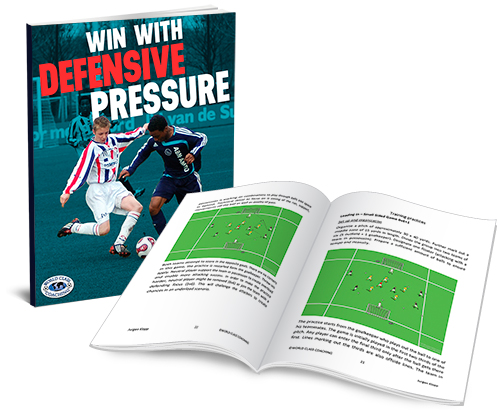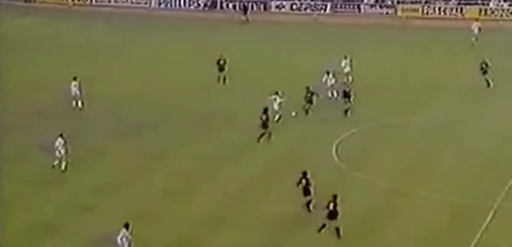WORLD CLASS COACHING
Win With Defensive Pressure
By Luca Bertolini

Table of Contents
PART ONE
INTRODUCTION
THREE DEFENSIVE PRINCIPLES CURRENTLY BEING PLAYED
PART TWO
HIGH AND STRONG 1V1 DEFENSIVE PRESSURE
HOW TO COACH IT
PART THREE
MULTIPLE 1V1 ON THE STRONG SIDE
PART FOUR
SMALL-SIDED GAMES
Introduction
The first idea of defensive pressure: Arrigo Sacchi AC Milan
"My arrival in Milan was very difficult. Meeting the team was very difficult, there was mistrust, but not prevention fortunately. I was used to saying different things about soccer, about the mentality to be placed on the field and about the planning of training sessions.
They thought I was a heretic coach. The environment of soccer and some of the journalists considered me subversive, different, an opponent. I was causing distress to their leadership and their role as holders of old-fashioned knowledge; on the other side, the young and the less conservative soccer people looked at me with interest." (Arrigo Sacchi)
Sacchi was the coach of the Italian 2nd league team during the 1986-87 season and his AC Parma defeated Liedholm's AC Milan two times; the first one during a summer friendly match and the second one in a national cup match. AC Parma zonal marking and strong pressure made AC Milan's chief Silvio Berlusconi "fall in love" with him as he wanted to sign him no matter what.
The Milan of Arrigo Sacchi was born during the summer of 1987 and that team has changed the modern history of soccer. Even today, the most popular soccer philosophies are based on the fundamental ideas of Sacchi.
Guardiola, Mourinho, Bielsa, Ancelotti, Klopp, Simeone, Sarri--everyone studied him, and everyone recognized his importance in their soccer training and playing philosophy; they developed the ideas in their own way, but the soccer that is played today at a high level is the one originally thought of by the last great coach-philosopher of Italian football.
Before Sacchi, all the Italian teams played with a "mixed zone.” Trapattoni's Juventus FC and Gigi Radice's Turin were the most popular teams that were using those tactics at the end of the ‘70s and the first half of the '80s. They required the players to cover the spaces and to mark the opponent systematically and at the same time. Sacchi was a revolution; he played with a "zonal marking.”
Sacchi won the league in his first attempt in 1987-1988, without Marco Van Basten, as he was injured for most of the season. Then he won two Champions Leagues and two Intercontinental Cups in a row during the following seasons.
Sacchi required his players to be active during the defensive phases of play through strong pressure against the opposition. The goal was to play with a zonal marking team defensive phase. The bases of everything were intelligence, concentration, a right placement of the players on the field and the skills of the players to choose the right movements. The defensive phase always started from the forwards who had the task of putting pressure against the opposition defenders while playing.
The second interesting point of his style of play was the offside trick that was a direct consequence of the pressure on the opposition; that was the first idea of defense running forward.
The biggest victory of Arrigo Sacchi was to convince those great players to follow him. The key to success of that team was the pressure and the ability to remain short and small on the field--the space between the defensive line the attacking line was small.
Sacchi removed the back free player and he placed four defenders on one moving line that was flat only when the ball was played in midfield and in possession of the opponents. The first reference of the defense placement was the ball, the second reference was teammates’ placement, and third, the opponents.
The very basis of all this was the "team.” The player needed to express himself within the team and inside a precise order set by the coach. He wanted clever men to be able to understand what he asked and generous men to make their intelligence useful for the team.
Note that the goalkeepers could catch the ball with hands after a back pass at that time. When we talk about pressure, we mean pressure against the possession phase and the attacking phase of the opposition; in the middle third and in the first third. The defense line was always very high even inside the opposition half.
Sacchi AC Milan defensive principles of play
High defense back four line. The basic formation was a 1-4-4-2 with the three lines of field players very close to one another. The line of defenders was always placed very high on the field, defending forward and using the offside tactic systematically.
The high defense allowed more space and time to be placed correctly, prevent space closures, to be short and close on the field, avoiding any attempt of opponent transitions through pressure and creating chances for transitions to attack.

We may say that the defense line attacked the "opposition's uncovered balls.” When the ball was uncovered, Sacchi asked the defenders to run backwards to cover the space between them and the goal to defend, but coming back to run forward at a first side or backward pass of the opposition even if the receiver could look at their goal.

Sacchi based his team's defensive phase of play on the systematic offside tactic. At that time for FIFA the "passive" or "active" offside players were the same and anyone beyond the last defender was offside.
Defend running forward. The defenders were placed very close to one another, sliding toward the side of play. They always attacked the ball to recover the possession.

Put strong pressure on the opponent with possession. The nearest player to the ball had to press 1 v 1 the opponent in possession waiting for a double marking or even for 3 or 4 teammate near the ball.

Put strong pressure against the opponent with possession. 2 v 1 duels are played against the opponents in possession.


Create numerical advantage near the ball. The lines of defenders and midfielders were very close to each other and this helped to create numerical advantage near the ball; moreover when they had to defend the first third,

and even inside the middle third. The attempt to isolate the opponent in possession from his teammate is very clear.

In this picture is very clear as the center backs and the center midfielders are so close to shape a 4 v 2 duel against the opponents.

Put pressure high on the field. Thinking about that times when the goalkeeper could catch the ball with his hands, to press high could easily avoid that. But if and when the possession was lost in the middle third, the first idea was to stay placed in the same area to press immediately and recover the possession

When the possession was lost inside the final third, the principle of defense play was the same; stay and press to recover the possession or to stop the possession phase of the opponents. Considering how all the defensive tactical ideas kept all the players behind the ball line starting from the middle third or the first third, high pressure defending was born.

So, what is the heritage of the most famous and maybe the most influential team of history?
The idea of defense to recover the ball as soon as possible with high, strong, and systematic pressure and closing spaces to prevent the opponent’s transition to attack.
The three principles of play currently in use
Thinking about the current game, these principles of play are the references for all the defensive phases, even if the rules of the game have changed.
Two rules change the game’s history more than all the others:
• only the active players near the ball and in front of the goalkeeper are considered as offside players when placed beyond the defense line
• the goalkeeper can't catch the ball with hands after a back pass of a teammate
The formations, the roles of the players, and the pattern of play are even changed, but these principles of play can be easily recognized in current matches. I would not include the rhythm of play, as AC Milan used to play with a very basic speed, both when in possession and when not in possession.
1. Defend to recover the possession as soon as possible and as near as possible to the opposition goal; not only to save the attacking attempts of the opposition.
2. The strong and systematic pressure against the opponents, moreover, on the first player in possession during the transitions to defend just after when the ball is lost. 1 v 1 duels and double marking duels are almost the same as Sacchi’s seasons. The biggest difference is the goalkeeper who can be attacked as all the other opponents as he must play the ball with feet and the very high pressure as direct consequence.
3. The passing lanes’ closure through the placement of the players is now used on the field to avoid the building up from the back and the play out moves of the opposition, first of all.
If we analyze two practical defensive principles of play that are coming from those pioneering seasons, they would be:
1. High and strong 1 v 1 defensive pressure
2. Close the passing lanes inside the opposition’s half


